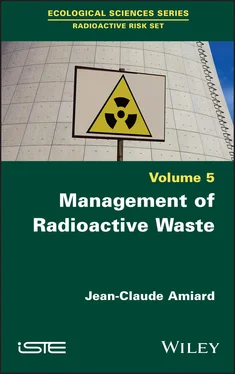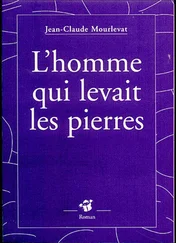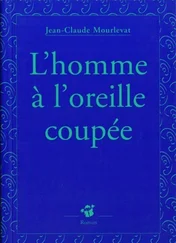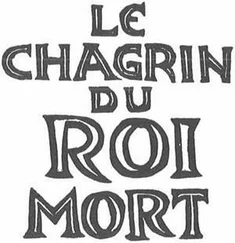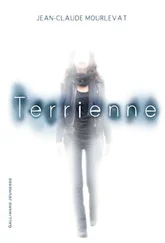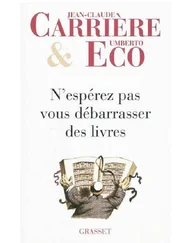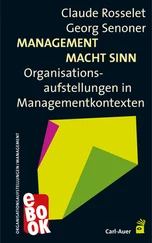1.4.2. Wastes related to the nuclear fuel cycle
A distinction should be made between two fuel cycles, the so-called open NFC and the closed NFC, the latter reprocessing spent nuclear fuel in order to reuse the extracted by-products (uranium and plutonium) in other reactors, whereas in the case of the open NFC, the spent fuel is considered as radioactive waste and therefore disposed of. A representation of the two types of fuel cycle is shown in Figure 1.3.
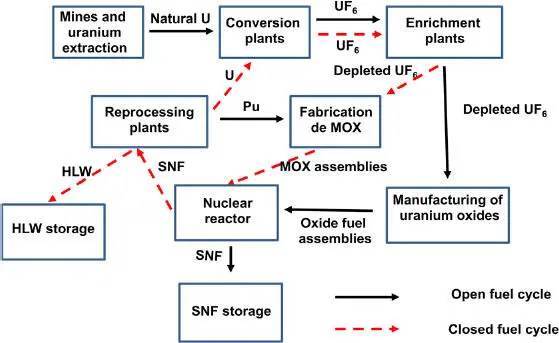
Figure 1.3. The various stages of the nuclear fuel cycles in open and closed versions (source: [OJO 14]). HLW: high-level waste; MOX: mixed oxide; NFC: nuclear fuel cycle; Pu: plutonium; SNF: spent nuclear fuel; U: uranium; UF6: uranium hexafluoride. For a color version of this figure, see www.iste.co.uk/amiard/radioactive.zip
The number of states reprocessing civilian spent fuel in 2013 was still six (China, France, India, Japan, the United Kingdom and Russia) with a theoretical annual reprocessing capacity of 5,900 tons to be increased to 6,700 tons [OJO 14]. In 2020, the United Kingdom gave up reprocessing and Japan has had its plants shut down for many years.
The chemical and radioactive composition of HLW varies greatly from state to state. Thus, for transuranium elements, the quantities present in HLW, expressed in g.L -1, are 2.0 for the British Magnox reactors, 5.1 for the waste from the La Hague reprocessing plant in France, 7.6 for the WIP (Waste Immobilization Plant) in India, 12.6 for the waste from the Tokai reprocessing plant in Japan and <0.1 for American Hanford waste. Similarly for fission products, the quantities expressed in g.L -1are 87.0 at La Hague, 1.1 at the Indian WIP, 49.0 for the Japanese Tokai plant and <2.5 for the Hanford waste. This can be explained by the characteristics of the reactors and nuclear fuels used, as well as by the cooling methods used and the reprocessing technologies [OJO 14].
1.4.3. Nuclear waste from electricity production
About 90% of radioactive waste comes from electricity generation. This waste is of three types. The first category includes waste of various origins (also called type A waste); these are chemical products, work clothes, tools, etc., generally of low radioactivity (18,000 t.yr -1in France). The second group contains technological waste related to the atomic fission process (also called type B waste); this is fairly highly radioactive waste, consisting in particular of metal structures and zircaloy “shells” (an alloy of zirconium and tin, about 1,800 t.yr -1in France). The last group includes waste resulting directly from the fission process of the atom itself (also called type C waste); these are fission products and actinides (approximately 63 t.yr -1and 1.9 t.yr -1, respectively, in France), i.e. volumes of 100–240 m 3.yr -1. Still for France, each year the nuclear industry produces more than 1,000 tons of spent fuel that is sent to the Orano (previously Areva) plant at La Hague. A portion is processed each year to extract the plutonium (1%) and uranium (95%) and to condition the residue (4%). This is the stage that produces by far the most radioactive waste [AMI 13]. The plutonium is reused in the manufacturing of new fuels (MOX), which are composed of a mixture of plutonium and uranium oxides. There are currently 2,140 tons of irradiated MOX fuel, while 424 tons are loaded into 900 MW reactors [AND 20c].
The quantities of low- and intermediate-level radioactive waste and the tonnage of spent nuclear fuel generated vary widely among the nuclear technologies ( Table 1.8.).
Table 1.8. Quantities of radioactive waste (m3.GW-1) and spent fuel (t.GW-1.yr-1) generated by the various types of nuclear reactors in operation (source: [OJO 14]). LWR: light-water reactor; BWR: boiling water reactor; PWR: pressurized water reactor; WWER: water-water energy reactor; RBMK: Reaktor Bolshoy Moshchnosti Kanalnyi, CANDU: Canadian dioxide uranium; Magnox: magnesium non-oxidizing; AGR: advanced gas-cooled reactor
|
LWR |
BWR |
PWR |
WWER |
RBMK |
CANDU |
Magnox |
AGR |
| LLW and ILW |
100 |
260 |
130 |
320 |
850 |
80 |
1,740 |
400 |
| Spent fuel |
25 |
22 |
20 |
28 |
42 |
145 |
240 |
29 |
1.4.4. Nuclear waste related to military activities
Nuclear defense facilities, many of which are currently being dismantled, have generated waste in the past that has not been treated. This old waste, stored in the facilities of the time, will have to be taken back and conditioned. The current maintenance of nuclear weapons also generates waste in small quantities. This waste is managed in the same way as waste from the civilian industry.
The radioactive waste, Soviet and then Russian, dumped in the Kara Sea in 1993–1994 is relatively large ( Table 1.9) [NYF 03].
Table 1.9. Radioactive waste dumped in the Kara Sea in the Arctic Ocean in 1993-1994 (source: [NYF 03])
| Waste category |
Material |
Number of objects |
Total activity (TBq) |
| High activity |
Reactors with fuel or containers |
7 |
4,700 |
| Intermediate activity |
Fuel-less reactors |
10 |
20 |
| Low or intermediate activity |
Containers |
6,508 |
580 |
| Large objects |
154 |
| Vessels |
15 |
1.4.5. Wastes related to medical and industrial uses
Radionuclides have many uses in medicine and biological research. There are about 23 radionuclides that are used as radioactive tracers for various diagnostic purposes. Other radionuclides are present in sealed sources and serve as sources of ionizing radiation for medical, industrial and research applications [AMI 13]. The types of sealed sources are very varied and there are about 52 types of irradiators [IAE 19a].
Various medical and industrial, civilian and military accidents have occurred with abandoned irradiators [AMI 18, AMI 19].
Some industrial activities, such as chemical treatment related to the production of rare earths or the manufacture of phosphate fertilizers, lead to the concentration of natural radioactivity in a residue that becomes radioactive waste. This is particularly the case for the Rhodia plant in La Rochelle (Charente Maritime).
Many radioactive sources in sealed form are used in medicine to treat cancer (brachytherapy). They are used in industry to radiograph welds to test their integrity, to measure the water content of soil and for many other applications. They are also used in research or medicine to establish diagnoses (scintigraphy) or to treat certain cancers (thyroid) as radioactive tracers, in liquid form. The quantity of waste generated is small, but there are more than a thousand users scattered over the French territory [AMI 13].
1.4.6. Nuclear waste related to the dismantling of nuclear installations
The CEA monograph [CEA 17] details the various processes for treating materials resulting from dismantling. During the clean-up and dismantling of a nuclear installation, the various treatments generate a wide variety of wastes, organic wastes, graphite wastes, magnesian wastes and very special wastes such as mercury wastes. High-level waste in sludge or powder form and tritiated waste are also produced.
Читать дальше
